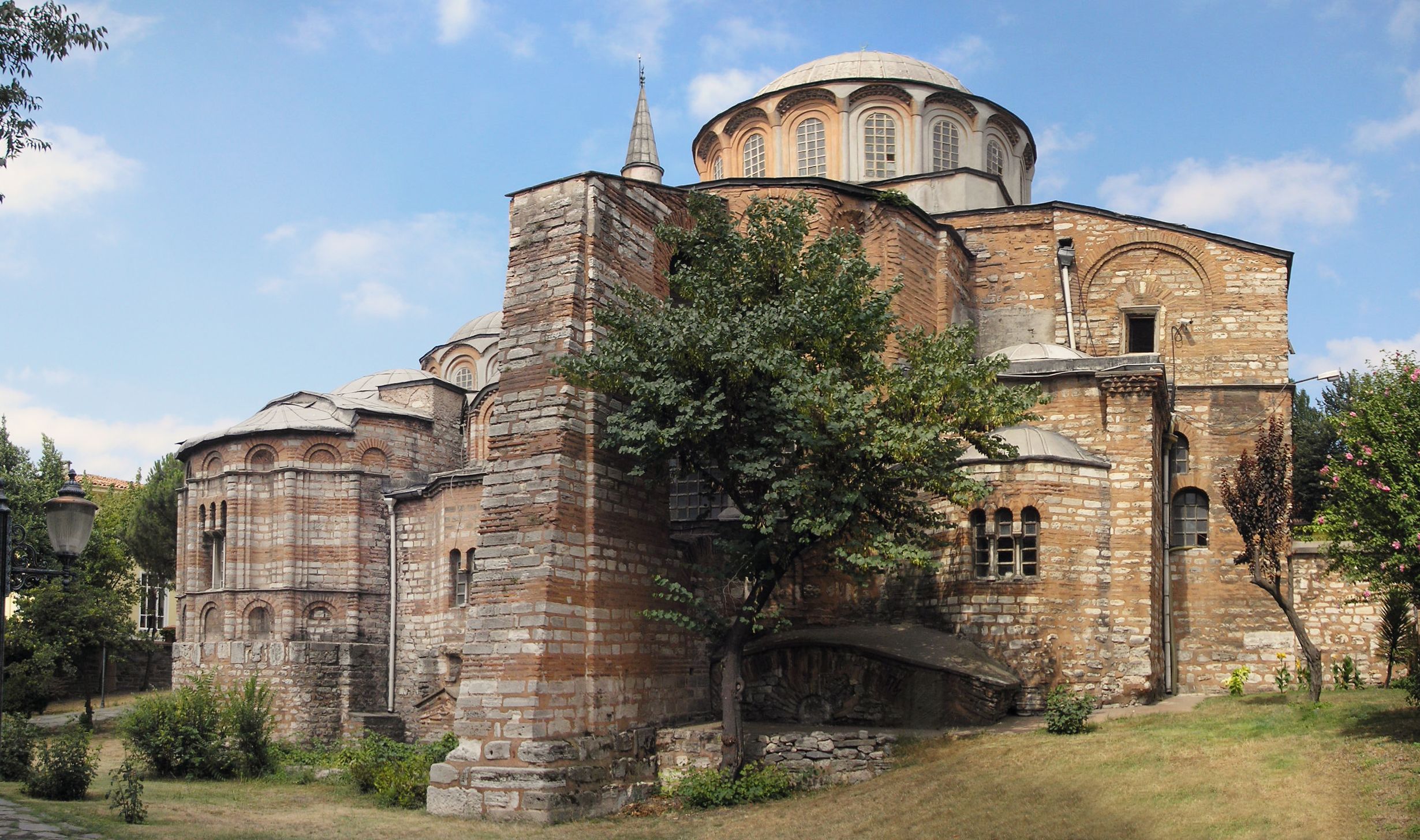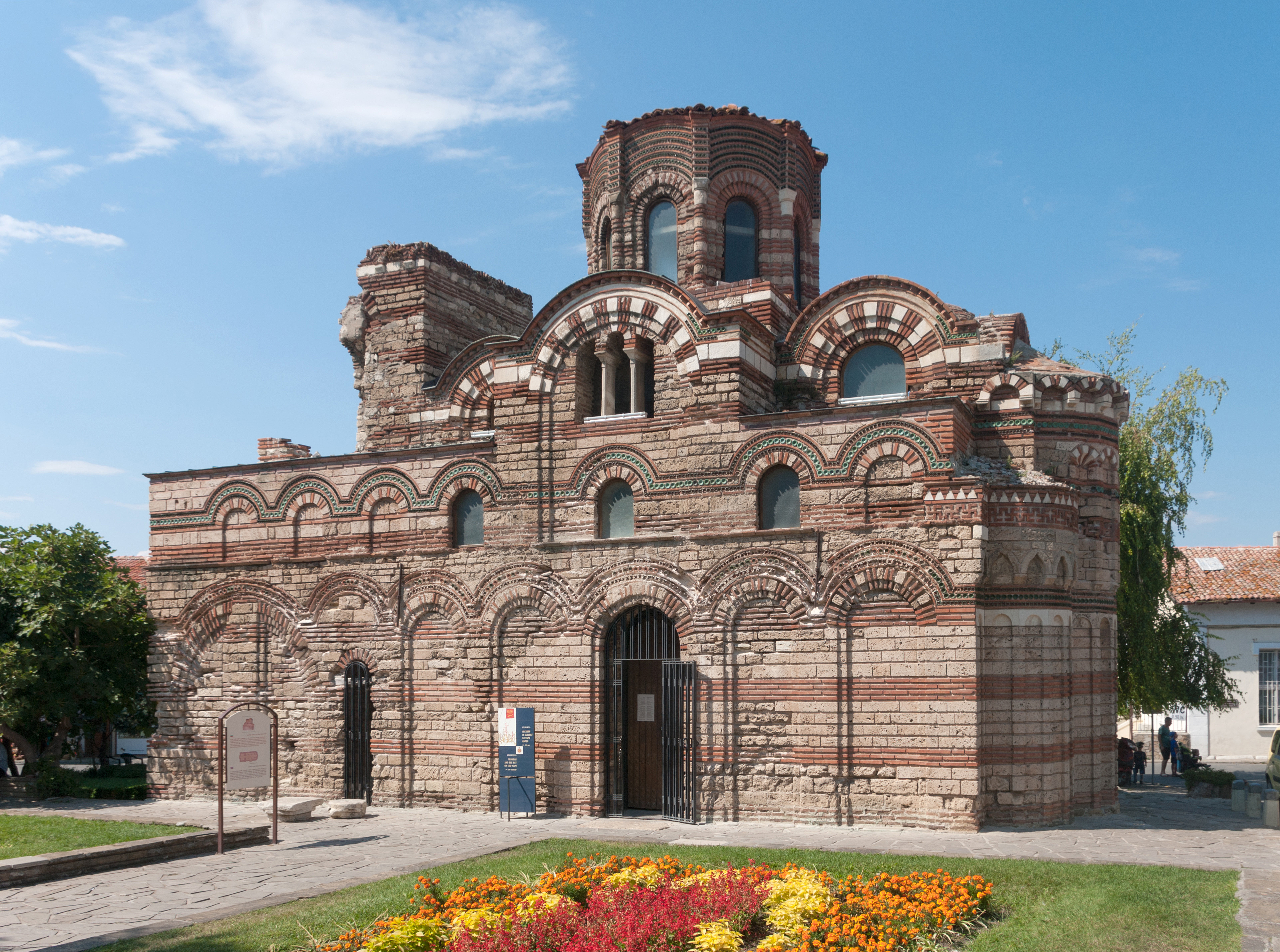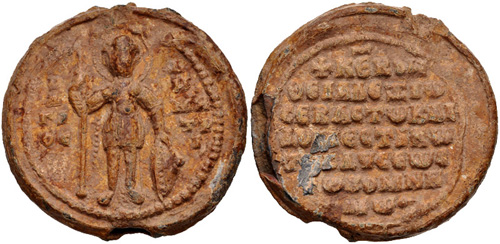|
Chora Church
The Chora Church or Kariye Mosque () is a Byzantine architecture, Byzantine church, now converted to a mosque (for the second time), in the Edirnekapı, Istanbul, Edirnekapı neighborhood of Fatih district, Istanbul, Turkey. It is famous for its outstanding Late Byzantine mosaics and frescos. In the 16th century, during the Ottoman Empire, Ottoman era, it was converted into a mosque; it became a museum in 1945, and was turned back into a mosque in 2020 by President Recep Tayyip Erdoğan. The interior is covered with some of the finest surviving Byzantine Christian mosaics and frescoes, which were left in plain sight during Muslim worship throughout much of the Ottoman era. They were restored after the building was secularized and turned into a museum. The church in the western Fatih district of İstanbul. It stands on sedimentary layers and anthropogenic infills on a slope descending towards the north. It is oriented east-west, as are typical Byzantine churches throughout the ... [...More Info...] [...Related Items...] OR: [Wikipedia] [Google] [Baidu] [Amazon] |
Byzantine Architecture
Byzantine architecture is the architecture of the Byzantine Empire, or Eastern Roman Empire, usually dated from 330 AD, when Constantine the Great established a new Roman capital in Byzantium, which became Constantinople, until the Fall of Constantinople, fall of the Byzantine Empire in 1453. There was initially no hard line between the Byzantine and Roman Empires, and early Byzantine architecture is stylistically and structurally indistinguishable from late Roman architecture. The style continued to be based on arches, vaults and domes, often on a large scale. Wall mosaics with gold backgrounds became standard for the grandest buildings, with frescos a cheaper alternative. The richest interiors were finished with thin plates of marble or coloured and patterned stone. Some of the columns were also made of marble. Other widely used materials were bricks and stone. Mosaics made of stone or glass tesserae were also elements of interior architecture. Precious wood furniture, like be ... [...More Info...] [...Related Items...] OR: [Wikipedia] [Google] [Baidu] [Amazon] |
Fatih
Fatih () is a municipality and district of Istanbul Province, Turkey. Its area is 15 km2, and its population is 368,227 (2022). It is home to almost all of the provincial authorities (including the mayor's office, police headquarters, metropolitan municipality and tax office) but not the courthouse. It encompasses the historical peninsula, coinciding with old Constantinople. In 2009, the district of Eminönü, which had been a separate municipality located at the tip of the peninsula, was once again remerged into Fatih because of its small population. Fatih is bordered by the Golden Horn to the north and the Sea of Marmara to the south, while the Western border is demarked by the Theodosian wall and the east by the Bosphorus Strait. History Byzantine era Historic Byzantine districts encompassed by present-day Fatih include: ''Exokiónion'', ''Aurelianae'', ''Xerólophos'', '' ta Eleuthérou'', ''Helenianae'', ''ta Dalmatoú'', ''Sígma'', '' Psamátheia'', ''ta K ... [...More Info...] [...Related Items...] OR: [Wikipedia] [Google] [Baidu] [Amazon] |
Christianity Today
''Christianity Today'' is an evangelical Christian media magazine founded in 1956 by Billy Graham. It is published by Christianity Today International based in Carol Stream, Illinois. ''The Washington Post'' calls ''Christianity Today'' "evangelicalism's flagship magazine". ''The New York Times'' describes it as a "mainstream evangelical magazine". On August 4, 2022, Russell D. Moore—notable for denouncing and leaving the leadership of the Southern Baptist Convention—was named the incoming ''Christianity Today'' Editor-in-Chief. ''Christianity Today'' has a print circulation of approximately 110,000 and an online readership of 2.2 million at ChristianityToday.com. The founder, Billy Graham, stated that he wanted to "plant the evangelical flag in the middle of the road, taking the conservative theological position but a definite liberal approach to social problems". Other active publications currently active within ''Christianity Today'' include: ''Building Church Leader ... [...More Info...] [...Related Items...] OR: [Wikipedia] [Google] [Baidu] [Amazon] |
Earthquake
An earthquakealso called a quake, tremor, or tembloris the shaking of the Earth's surface resulting from a sudden release of energy in the lithosphere that creates seismic waves. Earthquakes can range in intensity, from those so weak they cannot be felt, to those violent enough to propel objects and people into the air, damage critical infrastructure, and wreak destruction across entire cities. The seismic activity of an area is the frequency, type, and size of earthquakes experienced over a particular time. The seismicity at a particular location in the Earth is the average rate of seismic energy release per unit volume. In its most general sense, the word ''earthquake'' is used to describe any seismic event that generates seismic waves. Earthquakes can occur naturally or be induced by human activities, such as mining, fracking, and nuclear weapons testing. The initial point of rupture is called the hypocenter or focus, while the ground level directly above it is the ... [...More Info...] [...Related Items...] OR: [Wikipedia] [Google] [Baidu] [Amazon] |
Cross-in-square
A cross-in-square or crossed-dome floor plan was the dominant form of church architecture in the middle and late Byzantine Empire. It featured a square centre with an internal structure shaped like a cross, topped by a dome. Architecture Architectural form A cross-in-square church is centered around a quadratic cella, naos (the 'square') which is divided by four columns or piers into nine bay (architecture), bays (divisions of space). The inner five divisions form the shape of a quincunx (the 'cross'). The central bay is usually larger than the other eight, and is crowned by a dome which rests on the columns. The four rectangular bays that directly adjoin this central bay are usually covered by barrel vaults; these are the arms of the "cross" which is inscribed within the "square" of the naos. The four remaining bays in the corner are usually Groin vault, groin-vaulted. The spatial hierarchy of the three types of bay, from the largest central bay to the smallest corner bays, i ... [...More Info...] [...Related Items...] OR: [Wikipedia] [Google] [Baidu] [Amazon] |
Alexius I Comnenus
Alexios I Komnenos (, – 15 August 1118), Latinized as Alexius I Comnenus, was Byzantine emperor from 1081 to 1118. After usurping the throne, he was faced with a collapsing empire and constant warfare throughout his reign, Alexios was able to curb the Byzantine decline and begin the military, financial, and territorial recovery known as the Komnenian restoration. His appeals to Western Europe for help against the Seljuk Turks were the catalyst that sparked the First Crusade. Although he was not the first emperor of the Komnenian dynasty, it was during his reign that the Komnenos family came to full power and initiated a hereditary succession to the throne. The son of John Komnenos and a nephew of Isaac I Komnenos, Alexios served with distinction under three Byzantine emperors. In 1081, he led a rebellion against Emperor Nikephoros III Botaneiates and took the throne for himself. He immediately faced an invasion of the western Balkans by the Normans under Robert Gui ... [...More Info...] [...Related Items...] OR: [Wikipedia] [Google] [Baidu] [Amazon] |
Maria Of Bulgaria
Maria of Bulgaria (died 21 November, after 1095), known as Maria Doukaina () in the Byzantine sources, was the wife of ''protovestiarios'' and ''domestikos ton scholon'' Andronikos Doukas (cousin of Michael VII), Andronikos Doukas and mother of Empress Irene Doukaina. Life Maria was a daughter of Troian of Bulgaria by an unnamed Byzantine Aballantissa noblewoman, daughter of Strategos Romanos Aballantes, descended from the families of Kontostephanos and Phokas (Byzantine family), Phokas, and thus a granddaughter of Ivan Vladislav of Bulgaria, Ivan Vladislav and Maria (wife of Ivan Vladislav), Maria, the last rulers of the First Bulgarian Empire. Maria married Andronikos Doukas (cousin of Michael VII), Andronikos Doukas well before 1066. Her husband was a son of the ''Caesar (title), Caesar'' John Doukas (Caesar), John Doukas, a major power player in Byzantine politics of the era, and Eirene Pelagonitissa. He was also a nephew of Constantine X and first cousin of Michael VII. Mar ... [...More Info...] [...Related Items...] OR: [Wikipedia] [Google] [Baidu] [Amazon] |
Name
A name is a term used for identification by an external observer. They can identify a class or category of things, or a single thing, either uniquely, or within a given context. The entity identified by a name is called its referent. A personal name identifies, not necessarily uniquely, a ''specific'' individual human. The name of a specific entity is sometimes called a proper name (although that term has a philosophical meaning as well) and is, when consisting of only one word, a proper noun. Other nouns are sometimes called "common names" or (obsolete) "general names". A name can be given to a person, place, or thing; for example, parents can give their child a name or a scientist can give an element a name. Etymology The word ''name'' comes from Old English ''nama''; cognate with Old High German (OHG) ''namo'', Sanskrit (''nāman''), Latin ''Roman naming conventions, nomen'', Greek language, Greek (''onoma''), and Persian language, Persian (''nâm''), from the Proto-In ... [...More Info...] [...Related Items...] OR: [Wikipedia] [Google] [Baidu] [Amazon] |
Theodosius II
Theodosius II ( ; 10 April 401 – 28 July 450), called "the Calligraphy, Calligrapher", was Roman emperor from 402 to 450. He was proclaimed ''Augustus (title), Augustus'' as an infant and ruled as the Eastern Empire's sole emperor after the death of his father Arcadius in 408. His reign was marked by the promulgation of the Theodosian law code and the construction of the Theodosian Walls of Constantinople. He also presided over the outbreak of two great Christological controversies, Nestorianism and Eutychianism. Early life Theodosius was born on 10 April 401 as the only son of Emperor Arcadius and his wife Aelia Eudoxia.''PLRE'' 2, p. iarchive:prosopography-later-roman-empire/PLRE-II/page/1100/mode/2up, 1100 On 10 January 402, at the age of 9 months, he was proclaimed co-''augustus'' by his father, thus becoming the youngest to bear the imperial title Michael III, up to that point. On 1 May 408, his father died and the seven-year-old boy became the sole emperor of the Ea ... [...More Info...] [...Related Items...] OR: [Wikipedia] [Google] [Baidu] [Amazon] |
Golden Horn
The Golden Horn ( or ) is a major urban waterway and the primary inlet of the Bosphorus in Istanbul, Turkey. As a natural estuary that connects with the Bosphorus Strait at the point where the strait meets the Sea of Marmara, the waters of the Golden Horn help define the northern boundary of the peninsula constituting "Old Istanbul" (ancient Byzantium and Constantinople), the tip of which is the promontory of Sarayburnu, or Seraglio Point. This estuarial inlet geographically separates the historic center of Istanbul from the rest of the city, and forms a Horn (anatomy), horn shape, sheltered harbor that in the course of history has protected Greeks, Greek, Ancient Rome, Roman, Byzantine Empire, Byzantine, Ottoman Empire, Ottoman and other maritime trade ships for thousandsBBC: "Istanbul's ancient past unearthed"< ... [...More Info...] [...Related Items...] OR: [Wikipedia] [Google] [Baidu] [Amazon] |
Constantine I (emperor)
Constantine I (27 February 27222 May 337), also known as Constantine the Great, was a Roman emperor from AD 306 to 337 and the first Roman emperor to convert to Christianity. He played a Constantine the Great and Christianity, pivotal role in elevating the status of Christianity in Rome, Edict of Milan, decriminalising Christian practice and ceasing Persecution of Christians in the Roman Empire, Christian persecution. This was a turning point in the Historiography of the Christianization of the Roman Empire, Christianisation of the Roman Empire. He founded the city of Constantinople (modern-day Istanbul) and made it the capital of the Empire, which it remained for over a millennium. Born in Naissus, a city located in the Roman province, province of Moesia Superior (now Niš, Serbia), Constantine was the son of Flavius Constantius, a Roman army officer from Moesia Superior, who would become one of the four emperors of the Tetrarchy. His mother, Helena, mother of Constantin ... [...More Info...] [...Related Items...] OR: [Wikipedia] [Google] [Baidu] [Amazon] |
Walls Of Constantinople
The Walls of Constantinople (; ) are a series of defensive wall, defensive stone walls that have surrounded and protected the city of Constantinople (modern Fatih district of Istanbul) since its founding as the new capital of the Roman Empire by Constantine the Great. With numerous additions and modifications during their history, they were the last great fortification system of ancient history, antiquity, and one of the most complex and elaborate systems ever built. They were also the largest and strongest fortification in both the ancient and medieval world. Initially built by Constantine the Great, the walls surrounded the new city on all sides, protecting it against attack from both sea and land. As the city grew, the famous double line of the Theodosian Walls was built in the 5th century. Although the other sections of the walls were less elaborate, they were, when well-manned, almost impregnable for any medieval besieger. They saved the city, and the Byzantine Empire with ... [...More Info...] [...Related Items...] OR: [Wikipedia] [Google] [Baidu] [Amazon] |








